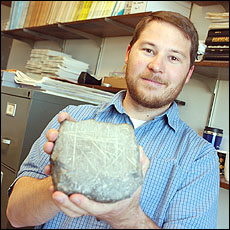Archives
WNY perfect lab for glacial geologist
Newest member of geology department studies vanishing plateau of ice caps
By IRENE LIGUORI
Reporter Contributor
Earlier this month, Jason P. Briner and a group of geology students trekked across northern Batavia to delve into glacial deposits.
Wait a minute—glacial deposits?

Jason Briner says the scratches on this
rock he found along the Buffalo waterfront show glacial movements.
Western New York and all of Canada once were covered by an ice sheet, he
says.
PHOTO: NANCY J. PARISI
Yes, Western New York and all of Canada once hunkered down beneath hundreds of feet of ice sheet, says UB's newest glacial geologist. He says that makes the university's environs a perfect outdoor laboratory for him.
So is the Arctic. Fresh from the University of Colorado at Boulder, where he was conducting postdoctoral research, Briner plans to lead a National Science Foundation (NSF)-funded field investigation in the Arctic this summer to launch a three-year study of the vanishing plateau ice caps of north-central Baffin Island in Canada.
"The Arctic is warming faster than the rest of the planet right now," notes Briner, an assistant professor in the Department of Geology, College of Arts and Sciences. "The globe has warmed seven-tenths of a degree in the last century, whereas the Arctic has warmed a couple of degrees."
Briner's summer work actually encompasses not just one, but three new, separately funded grants from the NSF, all of which were awarded a month after he arrived at UB in January. In addition to the vanishing ice caps, he will be studying constraints on landscape evolution in the fjorded margin of the northeastern Laurentide Ice Sheet and conducting a study of the last 2,000 years of climate variability data from Arctic lakes.
Picture being dropped off in the Arctic by a mining-company helicopter, skimming over a wilderness landscape by snowmobile, dodging polar bears, collecting rocks and hammering long plastic tubes into lake beds to unravel the ecological mysteries of past climates. This is a portrait of Briner's life during numerous past summers. He's made friends among the Inuit people of the Clyde Region village where he bases himself for his study visits on Baffin Island. And he can't wait to take a group of students with him.
"One of my goals here is to get more students to go to the Arctic," he says. "My other goal is to start exploring our 'back yard' right here in Buffalo."
He's also done fieldwork in southeast, southwest and interior Alaska, as well as in that state's Brooks Range, in Iceland, Puget Lowland in Washington and in East Africa.
Briner says geology was the perfect marriage of two passions for him: his love of science and his love of the outdoors. He's an avid skier and fly fisherman. He also truly enjoys teaching. "It's a chance for me to convey my enthusiasm," Briner says. "I always was turned on by teachers who were really excited about what they did."
While a Ph.D. student at the University of Colorado, Briner says he mentored six undergraduate students—one of whom led his own field investigation on Baffin Island, completed laboratory work on collected samples and presented his results at the annual Geological Society of America meeting.
Briner has presented his own research results at international meetings at least twice per year since 1998, when he received his M.S. from Utah State University. He also maintains research Web sites, including a page directed toward a general audience at http://instaar. colorado.edu/cosmolab/.
It was the prompting of retired UB faculty member Parker Caulkin, who now lives in Boulder, that drew Briner to UB. "Everyone here is very productive and successful," he says of UB's geology faculty. "It sounded like an atmosphere that I wanted to be a part of."
Briner grew up in the Seattle area, another place covered by an ice sheet during the Ice Age. He enrolled at the University of Washington, which has an active research program in glacial geology. There he secured a research position in a lab and had an opportunity to visit Alaska as a field assistant with a doctoral candidate. It was his first real chance to think and "do" science, and that field and lab experience committed him to his profession.
As a glacial geologist, Briner seeks to unravel clues from—among other things—isotopes in the Earth's crust. Earth is bombarded by cosmic rays that only penetrate the upper 10 feet of its surface. Glaciers erode these isotopes. By studying different degrees of erosion, scientists like Briner can reconstruct the timing of glacial events and also reconstruct the behavior of glacial events and ice sheets.
"This gives us insight into Earth's climate system," Briner says. "We are striving to understand how our ice sheets are going to behave in the near future with global warming, using climate variability as a context."
Since the advent of satellite imagery, Briner's particular field of study has really been able to accelerate in ways it could not before.
In addition to his current NSF grants, Briner has served as either principal investigator or coprincipal investigator for four others—including studies of Holocene climate evolution on millennial timescales in Arctic Canada, basal conditions of ice sheets and basal flow dynamics.
As a doctoral student, he worked on other NSF projects involving the application of cosmogenic exposure dating to constrain chronology and glacial style in the Eastern Canadian Arctic and another study that entailed dating outlet and local glacier moraines in the Clyde Region with cosmogenic isotopes.
Briner's wife, Yarrow Axford, is finishing her doctorate in geology and will be joining him in Buffalo this summer.
